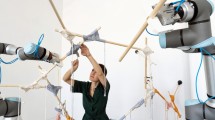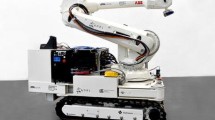Abstract
The paper presents a craft-oriented middleware for assisting in situ robotic fabrication. This middleware addresses the need for sensor-based feedback in robotic fabrication involving uncertain materials, non-structured environments, or post-production surfaces. The presented middleware addresses these fabrication challenges by allowing the robot to react to its environment without the need for a predetermined program. The middleware and its components are presented, followed by experiments demonstrating in situ capacities. The first experiment demonstrates autonomous carving—performing an iterative, non-prescribed robotic fabrication process. The second experiment presents integrated fabrication—a sequence of subtractive and additive techniques performed on a non-even substrate. Together, these experiments contribute to the implementation of sensible robotic middleware in architecture and assist in restoring the lost link between workmanship and construction sites.










Similar content being viewed by others
References
Amtsberg F, Raspall F, Trummer A (2015) Digital-material feedback in architectural design. In: Proceedings of the 20th international conference on computer-aided architectural design research in Asia. CAADRIA, Daegu, South Korea, pp 631–640
Bard JD, Blackwood D, Sekhar N, Smith B (2015) Decorative robotic plastering—a case study of real-time human machine-collaboration in high-skill domains. In: Martens B, Wurzer G, Grasl T, et al (eds) Proceedings of the 33rd eCAADe conference. eCAADe, Vienna, Austria, pp 383–388
Batliner C, Newsum MJ, Rehm MC (2015) Live: real-time platform for robot design interfaces. In: Martens B, Wurzer G, Grasl T, et al (eds) Proceedings of the 33rd eCAADe conference. eCAADe, Vienna, Austria, pp 277–286
Braumann J, Brell-cokcan S (2015) Adaptive robot control: new parametric workflows directly from design to kuka robots. In: Martens B, Wurzer G, Grasl T, et al. (eds) Proceedings of the 33rd eCAADe conference. eCAADe,Vienna, Austria, pp 243–250
Brell-Çokcan S, Braumann J (2011) Parametric robot control: integrated cad/cam for architectural design. In: Proceedings of the 31st annual conference of the association for computer aided design in architecture. ACADIA, Banff, Alberta, pp 242–251
Brugnaro G, Hanna S (2019) Adaptive robotic carving training methods for the integration of material performances in timber manufacturing. Springer International Publishing, New York, pp 336–348. https://doi.org/10.1007/978-3-319-92294-2
Burry M (2016) Robots at the sagrada familia basilica: a brief history of robotised stone-cutting. Springer, Berlin, pp 2–15
Canaan T (1933) The Palestinian Arab house, its architecture and folklore. Syrian Orphanage Press, Jerusalem
Dolley TP (2018) Stone, dimension. USGS 2016 minerals yearbook (September)
Dörfler K, Rist F, Rust R (2013) Interlacing. In: Rob| Arch 2012. Springer, pp 82–91
Dubor A, Camprodom G, Diaz GB, Reinhardt D, Saunders R, Dunn K, Niemelä M, Horlyck S, Alarcon-Licona S, Wozniak-O’Connor D, Watt R (2016) Sensors and workflow evolutions: develo** a framework for instant robotic toolpath revision. In: Reinhardt D, Saunders R, Burry J (eds) Robotic fabrication in architecture, art and design 2016. Springer International Publishing, Cham, pp 410–425. https://doi.org/10.1007/978-3-319-26378-6_33
Elkady A, Sobh T (2012) Robotics middleware: a comprehensive literature survey and attribute-based bibliography. J Robot 2012:1–15. https://doi.org/10.1155/2012/959013
Hayes J, Fai S, White P (2014) Digitally-assisted stone carving on Canada’s parliament hill. In: Thompson EM (ed) Proceedings of the 32nd eCAADe conference. eCAADe, Newcastle upon Tyne, UK, pp 643–651
Hurkxkens I, Mirjan A, Gramazio F, Kohler M, Girot C (2020) Robotic landscapes: designing formation processes for large scale autonomous earth moving. In: Gengnagel C, Baverel O, Burry J, RamsgaardThomsen M, Weinzierl S (eds) Impact: design with all senses. Springer International Publishing, Cham, pp 69–81
Johns RL (2014) Augmented materiality: modelling with material indeterminacy. Fabricate. gta Verlag, Zurich, pp 216–223
Jud D, Leemann P, Kerscher S, Hutter M (2019) Autonomous free-form trenching using a walking excavator. IEEE Robot Autom Lett 4(4):3208–3215
Rust R, Gramazio F, Kohler M (2016) Force adaptive hot-wire cutting. Adv Archit Geom 2016:288–305
Shaked T, Dubin U (2019) Exercises in style: a transdisciplinary discussion. In: Ahrens C, Sprecher A (eds) Instabilities and potentialities: notes on the nature of knowledge in digital architecture. Routledge, London
Shaked T, Bar-Sinai KL, Sprecher A (2020) Autonomous in craft: embedding human sensibility in robotic fabrication. In: Proceedings of the 25th international conference on computer-aided architectural design research in Asia. CAADRIA, Bangkok, Thailand, pp 243–252
Steinhagen G, Braumann J, Brüninghaus J, Neuhaus M, Brell-Çokcan S, Kuhlenkötter B (2016a) Path planning for robotic artistic stone surface production. Springer International Publishing, New York, pp 122–135. https://doi.org/10.1007/978-3-319-26378-6_9
Steinhagen G, Braumann J, Krewet C, Brüninghaus J, Brell-Cokcan S, Kuhlenkötter B (2016b) Robot based automation of artistic stone surface production. In: 47th International symposium on robotics, ISR 2016, vol 2016, pp 674–681
The Standards Institute of Israel (2012) Natural stone cladded walls: natural stone for cladding and general cladding system requirements. SII, Tel Aviv, Israel
Vasey L, Maxwell I, Pigram D (2014) Adaptive part variation. In: Robotic fabrication in architecture, art and design 2014. Springer, pp 291–304
Acknowledgements
The authors would like to thank the Technion IIT and the Azrieli Foundation for supporting this research; Yotam Carmel of Arco Preservation and Restoration; and A. Grebelsky & Son stone manufacturers for sharing their expertise. This research was conducted at the Material Topology Research Lab (MTRL), Technion IIT.
Author information
Authors and Affiliations
Corresponding author
Ethics declarations
Conflict of interest
The authors declare that they have no conflict of interest.
Additional information
Publisher's Note
Springer Nature remains neutral with regard to jurisdictional claims in published maps and institutional affiliations.
Rights and permissions
About this article
Cite this article
Shaked, T., Bar-Sinai, K.L. & Sprecher, A. Craft to site. Constr Robot 4, 141–150 (2020). https://doi.org/10.1007/s41693-020-00044-7
Received:
Accepted:
Published:
Issue Date:
DOI: https://doi.org/10.1007/s41693-020-00044-7




